#奥三河
A novel, of memorable liquor store and logging railroad 08
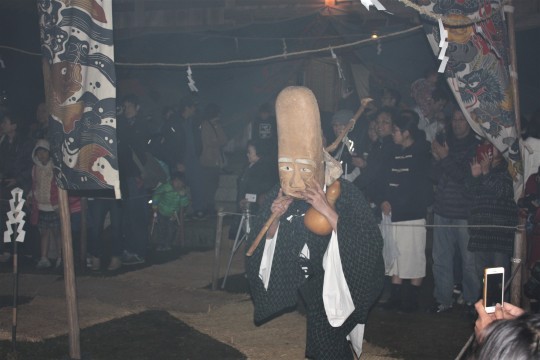
参候祭り sanzoro matsuri festival , belief in mountains in Japan
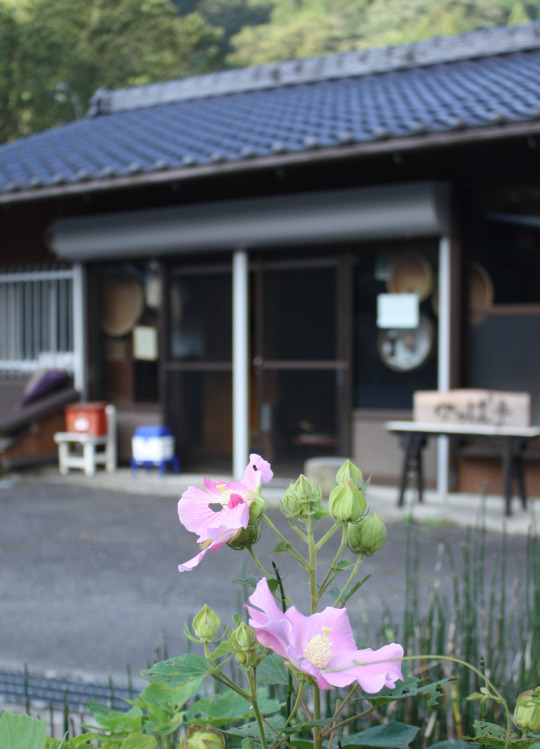
かっぱ亭(旧伊藤屋酒店)Kappatei (ex-Itoya liquor store), life in mountains
昭和23年(1948)10月のある朝。
太陽はまだ田峯の山の陰にある。空気はピンと澄んで、日ごとに秋の気配が深まっている。そういえばもうじき参候祭りだ。祭りの日を心待ちにする里の空気も、日ごとに募っている。それが、ちか子さんにはよく分かっていた。
重い玄関の引き戸を開けて、ちか子さんは言った。
「あなた。行ってらっしゃいませ」
「ああ」
正之さんはぶっきらぼうに答える。妻に優しげな言葉をかけようものなら、男の値打ちが下がる、そんな風な、張らずもがなの意地を張っている昭和の男の一人なのだった。
商店街の中を歩き去っていく夫の後ろ姿。5km余りの道を歩き、田峯の駅に出て、そこで初めて私鉄田口線に乗り、国鉄本長篠駅を経て、新城駅まで向かうのだ。通勤に2時間余もかかってしまう。
「仕事場がもう少し近くだったらいいのに」
そう、ちか子さんは思った。如何ともしがたい。正之さんは国鉄の職員だった。
ちか子さんは、歩み去っていく夫の背中に、海軍の白い制服を着たもう一人の人物の姿を重ね合わせた。
「あの人は、もっと遠くに行き、もっともっと遠くに行ってしまった」
つづく


「日本国有鐵道監修 職員用最新鐵道路線圖」昭和27年 伊藤正之氏遺品
折本の形で全国の鉄道路線図が収められている
Mr. Masayuki Ito’s belongings . All Japan railroad map for Japanese National Railways employee
One morning in October, 23rd year of Showa era(1948). The sun has not yet risen, it is behind Danine mountain. The air is cold and fresh. Day by day the climate tells us comming of autumn. Ms.Chikako knows the village people in Mitsuhashi are looking forward to the the day of Sanzoro festival. It’s a great festival of their village.
Ms. Chikako slided heavy door of their house and said to her husband . ‘Have a nice day’. 'Yes’ Mr.Masayuki responded laconically. Every man in Showa era thought it was a huge shame to utter to women frankly and gently. And he was one of them, too.
She see off him walking along shopping district. The private railroad station was more than 5km far from here. He had to walk that distance every day. Then he took a train for a while and next changed the train to Japanese National railways,,,, Ms. Chikako said to herself 'It is too far, he needs the place to work nearer ’.But they has no choice. Because Mr.Masayuki was a employee of Japanese National Railways.
Ms. Chikako superimposed another man’s figure having on white uniform on Mr.Masayuki’s back.
'He had gone farther, farther place. And never return’
to be continued
jump to the table of contents 目次のページへ
訪ねよう! 山の昭和と里のいにしえ

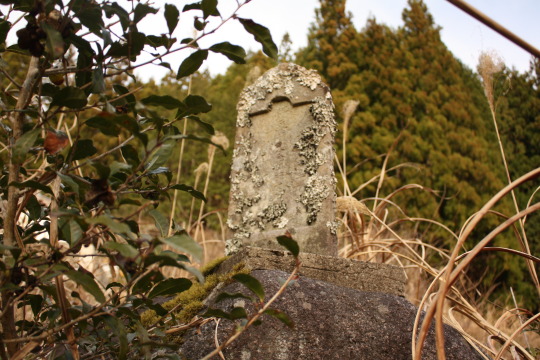
渡河地点をあとにして、森の奥へと入っていきます。すると、森林鉄道よりはるかに古い時代の文化の跡を目にすることができます。今にも壊れそうなお堂には、かつて観音様が祭られていました。11月の参候祭りでは観音様を乗せた神輿と稚児の行列が急な坂道を降りていき、津島神社に渡御するという式次第があったのです。今では観音様は別の建物に移されており、参候祭りの稚児行列はそちらが起点となっています。
線路跡が開けた田んぼの間を走るところでは、傍らに田の神様の石碑が建っています。日本の古い信仰では、毎年2月、山の神様が里に下りてきて田の神となり、稲作を守護してくれると信じられていました。そして、役目を終えた田の神様は、毎年10月には山に帰っていったのです。この石碑は、三都橋の人々の農作業を温かく見守っていたのでしょう。
田峯森林鉄道のレールや枕木は、今日ほぼすべて撤去されています。私の知っている限りでは折れ曲がったレールが顔を出しているところが一か所あるばかりです。一方、コンクリートで作られた遺物の方は、ところどころで見ることができます。山の産業遺跡ですね。

I leave the crossing site at the Mitsuhashi elementary school natural swimming pool and enter to forest. Then I can find many relics made by old culture in Japan. A temple building which is about to collapse was a hall for ‘Kannonsama’. Once village people enshrined 'Kannonsama’ in it. But people moved it to another temple building nearer their village, so today this building was avondoned.This Kannonsama plays a great part in Sanzoro-matsuri festival. I’m going to have another opportunty to talk you about it.
I can see a stone monument at the open space where the ex-railroad runs. It is a 'Tano kamisama (god of paddy field)’. In Japanese old faith people believed that Tanokamisama is also Yamanokamisama(god of mountain). In February Yamanokamisama comes down to paddy field in our village and changes its role to Tanokamisama, and it guards our agricultural work, then in October it returns to mountain. This is our folk and faith, very old faith.
As for this logging railroad most of rails and sleepers were removed. I know only one place where I can see the curved and bent rails. But in the forest I can find bridge pier or bridge beams. I think they are worth being said 'Industrial ruins’

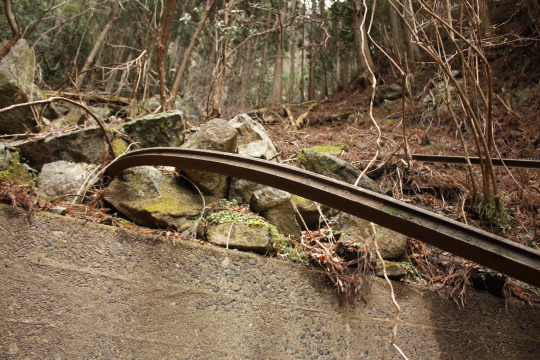
to be continued
→jump to the table of contents 目次のページへ
訪ねよう! 山の昭和と里のいにしえ
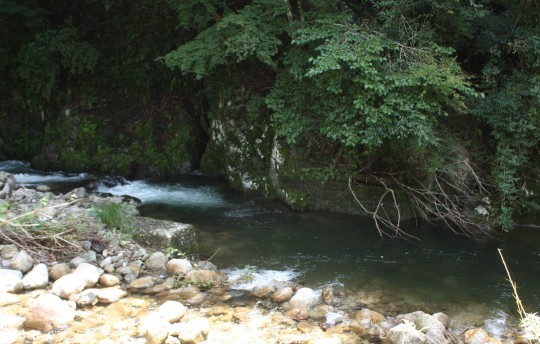
橋脚跡のコンクリーブロックと学校指定遊泳場所 natural swimming pool in the river

旧三都橋小学校 ex-Mitsuhashi elementary school
「いとや」(現かっぱ亭)の前の道は、子供たちの通学路でした。たくさんの子供たちが、毎朝ちか子さんの前を通り過ぎていったのでしょう。田峰森林鉄道鰻澤線は昭和33年には自動車輸送に道を譲り、廃線となります。しかし、「いとや」の商売はその後も長く続き、平成の時代まで商いを行っていました。
「いとや」から栗島川沿いの坂道を400mほど登ったところ、川のほとりの崖の上に、三都橋小学校は建っています。対岸を遡上してきた森林鉄道の軌道はこの地点で橋を渡り、こちら岸に来ます。そして、登校する子供たちの目の前で道路を横切ります。子供たちにとって森林鉄道の姿と、その走る音は、欠かせない日常の風景だったのでしょう。そして、もうひとつ。この橋の橋脚の足元の川の中は、学校指定の遊泳場所でありました。プールの無い学校だったので、栗島川の中の場所を指定して、学校公認の遊泳場所にしていたようです。学校の正門前に敷かれた軌道といい、川泳ぎといい、安全とか管理とかが口やかましく言われない時代なのでした。いかにも昭和、だったのです。たくさんの子供たちがかっぱのように川中で水浴びをしている、その頭上の橋を、トロッコがカタコトと音を立てて通り過ぎていく、そんな光景があったのでしょう。そして、子供たちは子供たちで、橋のうえに上って、橋げたの上を歩いて渡って、度胸試しをしたのでした。
橋を渡った森林鉄道は、再び森の中に潜り込み、木々の間を縫って上流を目指します。
A road in front of ‘Itoya-san’ was a school route. Every morning many children passed bofore Ms. Chikako’s eyes. The railroad was abandonded in Showa 33 (1957). But she ran her store for a long time until Heisei era.
Going up the slope way beside the river for 400m, children got to the elementary school building stands on the cliff by the river. The logging railroad ran up along the opposite side of the river and crossed the river on the bridge and appeared at the foot of the cliff which the school stands. Every morining and evening, the students saw the trucks move and hear the sounds given off from trucks. It was ordinaly scene for them. And one more thing. Mitsuhashi elementary school had no swimming pool. So teachers used the natural river instead of using artificial pool. The place in the river to swim was at the foot of the railroad bridge. The children swam like Kappa and the trucks loaded to capacity with logs went across above their heads. As for the children, they climbed the bridge and walked on it from this side to another. Of couerse it was to put their courage to the test.
There was no nervous minded person. That was Showa era.
After crossing the river, the logging railroad went into the forest again and headed to the upper stream.



A map for this chapter
→jump to the table of contents 目次のページへ
訪ねよう! 山の昭和と里のいにしえ
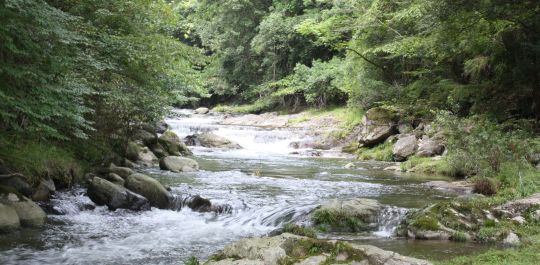
我が家のすぐ近くを流れる当貝津川 The river runs through Mitsuhashi
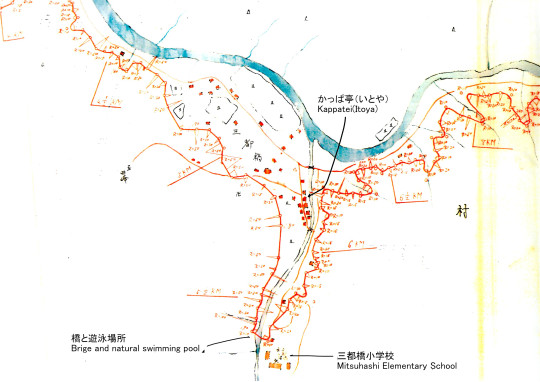
A map of logging railroad in Mitsuhashi, related this topic (written in 1947, retouched by Shige in 2019) 昭和22年に作成された三都橋地内の森林鉄道図。2019年にShigeが加筆
三都橋は二つの川の合流点に開けた集落です。 昭和22年に作成された「田峰森林鉄道台帳」に収録されている地図には、三都橋地内を流れ、合流する二つの川と、川に沿って走る森林鉄道が描かれています。
こういった資料や、地元の諸先輩や古老の皆さんにうかがった話などから見えてくるのは、活気にあふれた昭和前半の三都橋の姿です。国鉄飯田線本長篠駅から北設楽郡の郡衙である田口までは、田口線という私鉄が走っていました。この鉄道に接続する形で、「田峰森林鉄道鰻澤線」が敷設されたのが昭和6年。行き(上り)はガソリン駆動、帰り(下り)は自由落下走行、軌間762mmのトロッコでした。段戸山の御料林(のちに国有林)から伐り出された材木は、このトロッコによって運ばれ、竹桑田という所で田口線に積み替えられたのです。林業の隆盛に支えられ、森林鉄道の中核拠点である三都橋の里も大いににぎわっていました。自転車屋・鍛冶屋・パン屋・雑貨屋・酒屋など様々な店が軒を連ねていたのです。地図を見ると、たくさんの家が立ち並んでいるのが分かります。私の家「かっぱ亭」は、かつては伊藤さんというお宅が営む酒屋でした。酒屋であり、一杯飲み屋でもありました。いまでも、里の皆さんはこの家のことを「いとやさん」と屋号で呼びます。誰もが懐かしそうに、友情と敬意の響きを持って「いとやさん」と呼びます。その女あるじが、伊藤ちか子さんでした。
Long ago people came to the confluence of two rivers and established their village. That is Mitsuhashi. I have an old map of Mitsuhashi (written in 1947). You can see two rivers meet in the middle of the village and also you will notice the logging railroad running along the river.
I’ve read some books and interviewed with some senior people and got a vision of this village. The first half of Showa era (1926-1958), Mitsuhashi was a prosperous town. From Hon-nagashino St. to Takekuwada, there was a private railroad. And from Takekuwada, there were some logging railroads to ship logs. Small trucks driven by gasoline engine ran on the rail. When returning back, it was driven only by free fall. Mitsuhashi was one of important base of this railroad. Many workers and his families gathered to this village. So this village had many stores. Baker, bicycle shop, smith, grocery store and liquor store.
Yes, in those days, my house Kappatei was the liquor store which Ito family ran. The village people called, and even now call this house ‘Itoya-san’. It is a shop name. People use this name with respect and love. The proprietress of Itoya-san liquor store was Ms.Chikako Ito. She was popular with everyone.
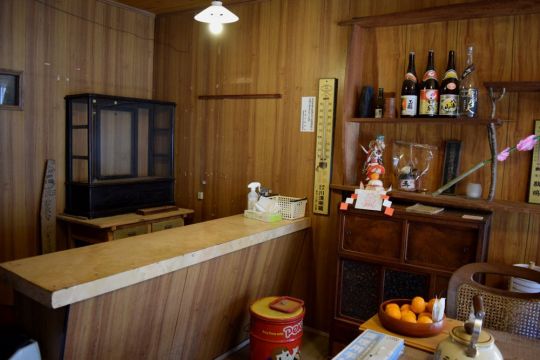
My house has a bar counter 民家なのにバーカウンターがあります。飲み屋さんだったころの名残。 棚の日本酒は今でも現役。時々、ご近所の皆さんと持ち寄り宴会を開きます

訪ねよう! 山の昭和と里のいにしえ
私の住んでいる三都橋は愛知県東部の深い深い山の中にあります。川の瀬音と降るような星空、朝は鳥の声に起こされ、夕方はヒグラシの合唱で一日を終えるという生活は、都市部では決して味わうことのできない生の喜びに満ちています。
古民家を入手し、Iターンでこの地に移ってきて2年目。いろいろなことが分かってきました。ひとことで言って、三都橋は歴史と民俗が重層している里なのです。少し散歩に出かければ、田の神様を祀った石碑があります。我が家から徒歩2分の津島神社では、 発祥が江戸時代以前にさかのぼるだろうといわれている民俗芸能が行われます。そして、築90年を数える私の家そのものが、三都橋の昭和の歴史の中で大きな役割を果たしていました。かつてこの家は酒場であり、森林鉄道で木を伐り出す木こりたちの憩いの場であったのです。まずは、物語を始めましょう。酒と木こりと森林鉄道の物語。
My home village Mitsuhashi is located among deep mountains. I can live my life with listening the sound of running water, seeing clear star lights, hearing the birds singing. It is a great pleasure which we could not have if we lived in the city area.
Two years have passed since I bought an old house and moved this village. I studied and noticed many matters. This village has many layers of folklife and history. A short walk takes me to the stone monument of ‘Tano kamisama (God of paddy field) ’. I live next to Tsushima Jinjja Shrine where we have very old folk festival having more than 400 years history. And my house itself, which was built 90years ago, played a part in the village history in Showa era. Once this house was a liquor store and was also pub. After their work at the logging railroad, lumberjacks stopped by this store and enjoyed drinking time.

参候祭り 稚児行列
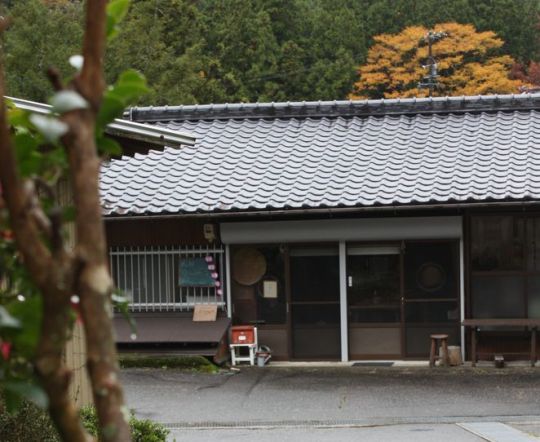
かっぱ亭
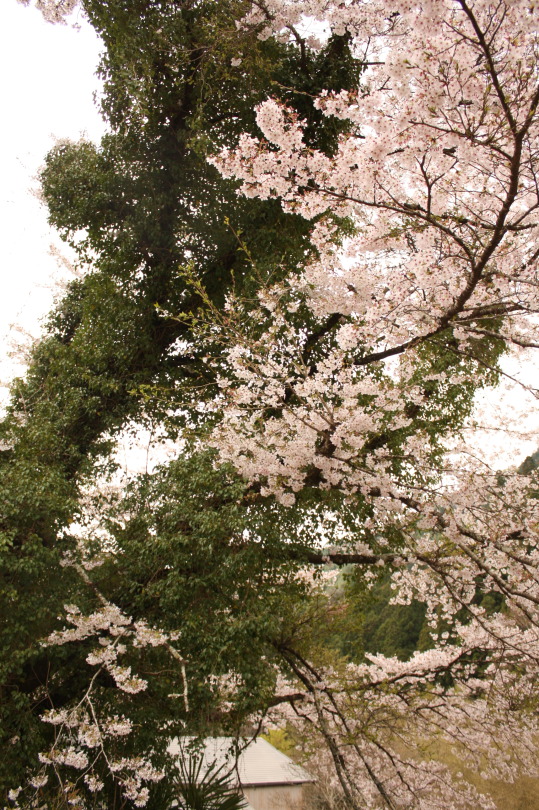

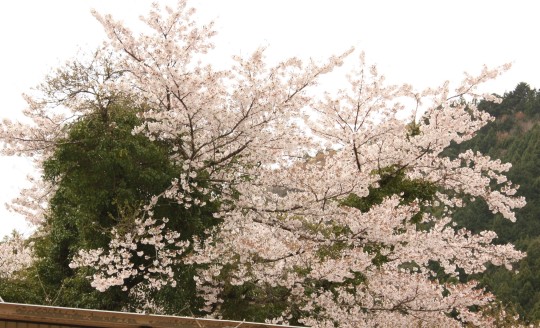
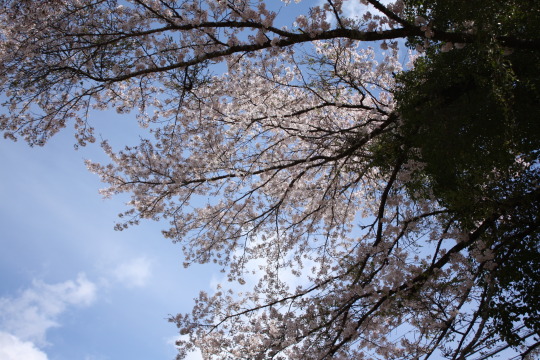
Recently every morning I make it a rule to go for a walk in order to see a sakura which I named 比翼連理の桜HIYOKURERNNRI NO SAKURA.
比翼連理 is very old phrase which we can find in Chinese poem called 長恨歌CHOGONKA. It is a long poem telling the story of emperor玄宗GENSO and his wife楊貴妃YOUKIHI. The emperor loved his wife so deeply, but loved too much. His attitude got his nation destabilized. The rebel army attacked the capital and 楊貴妃YOUKIHI was killed.
玄宗GENSO was left alone in deep grief, and remembered their promise. 'When we are in the sky, we are going to become a 比翼NOの鳥HIYOKU NO TORI’, ‘When we are on the ground we are going to become a 連理の枝RENRI NO EDA’.
'比翼の鳥HIYOKU NO TORI’ is a imaginary bird. Both male bird and female bird have only one eye and wing. So when they try to fly, they must make their bodies one and fly together.
連理の枝RENRI NO EDA is a word refers to two trees and their branches. Originally they were two trees. But branches fused and as a result of it the two became like one tree.
The word 比翼連理HIYOKURENRI is known as the word expressing a deep love of a couple in today’s Japan.
A sakura tree which I named 比翼連理の桜HIYOKURENRI NO SAKURA. This tree is pretty big and stands next to the national road in Mitsuhashi. But many drivers don’t see it even its flowers are in full bloom because those pink flowers are covered with green leaves. Approaching it on foot we can find thick vine creeping along the tree’s trunk. Its foliage covers whole tree and prevent drivers from finding the tree. The vine and the tree looks as if they were fused.
我が家から100mくらいのところに、私がひそかに「比翼連理の桜」と呼んでいる一風変わった桜の木があります。「比翼連理」といえば長恨歌にあるフレーズです。善政を行うのに疲れ果てた唐の玄宗皇帝は、美女楊貴妃を寵愛しますが、そのため国を揺るがす動乱が生じます。楊貴妃は戦乱の中で殺され、失意の玄宗は幸せだったころに二人で取り交わした約束を思い出すのです。
「天に在りては願わくは比翼の鳥と作らん、地に在りては連理の枝と為らん」
比翼の鳥とは、雌雄ともに一つ目・片翼しかない鳥で、飛ぶためには二羽が身を合わせる必要があります。連理の枝とは、二本の木のそれぞれの枝が融合して一本の木になったように見えるものを言います。転じて比翼連理とは夫婦や恋人の中が睦まじいことを言うのですね。
私が比翼連理の桜と呼ぶこの木は、まさに連理の枝なんです。国道のすぐわきになっているのに、花がみつかりづらい。なぜかといえば、絡みついた太い太いつる草が、桜の木をも、花をも、覆っているからです。近くに寄ってみるとわかるでしょう。つる草がすっかり木の幹と融合しているそのすがた。枝と枝ではありませんが、生き物が溶け合うその姿からは、人もかくあるべしという声が聞こえてきそうです。
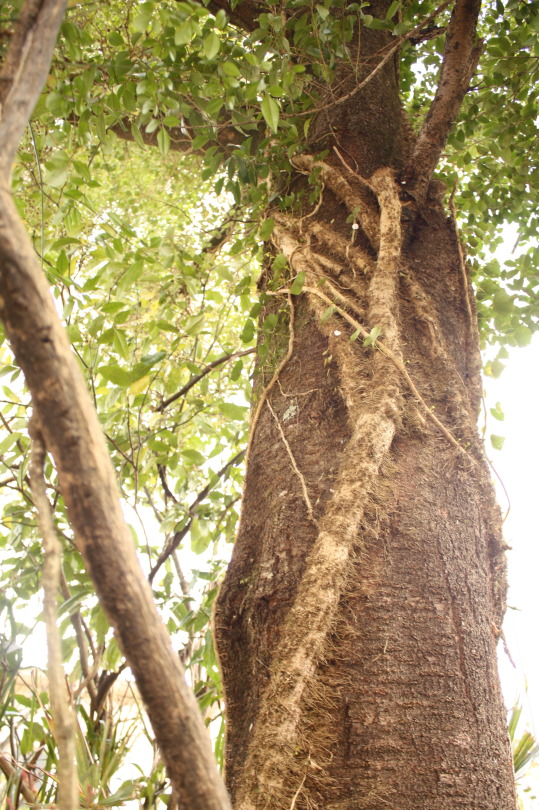
One day around KappaTei

